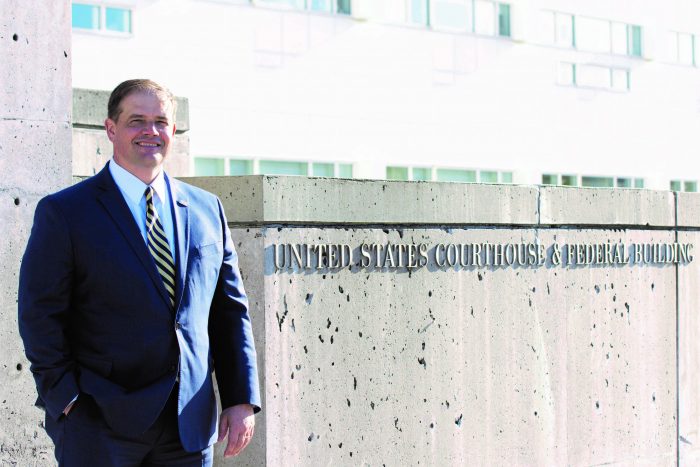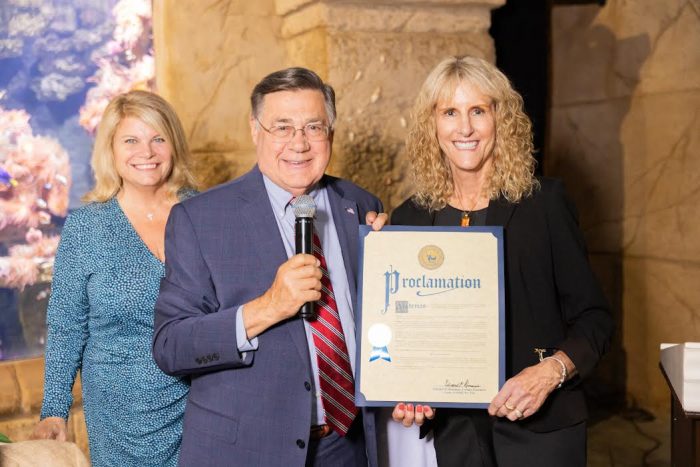The staff at TBR News Media wishes you and your family a wonderful holiday filled with the warmth and happiness of the season! The office will be closed for the holidays on Nov. 28 and 29. We will reopen on Monday, Dec. 2 from 10 a.m. to 4 p.m.
D. None of the Above: After Elon and Vivek fix the government, here’s a to do list
By Daniel Dunaief

The federal government? Yeah, of course. Heavy eye roll, shake of the head, shrug of the shoulders, palms to the sky and deep sigh. Oh, I almost forgot: quick puff of air directed upwards that lifts any hair hanging near a forehead.
No doubt the powerful tandem of Tesla creator Elon Musk and primary disruptor and climate change minimizer Vivek Ramaswamy will find plenty of ways to increase the efficiency and cut the budget from the federal government. I’m sure they will to trim redundant functions, shrink bureaucracy and cut costs, turning the behemoth into a well-oiled machine, filled with productive, engaged and excited workers and a smooth outward-facing electronic interface that enables quick and effective engagement between the people and their government.
But, hey, after the two weeks it takes to fix everything — okay, maybe it’ll take a bit longer — the tandem may be looking for other outlets for their efficiency efforts. I have a few suggestions.
Now, for the list:
— The DMV. I have interacted with some amazingly efficient and even accommodating workers at the DMV. Still, any time I go there, I recognize that I might spend several hours or more only to have to return again.
— Doctor’s offices. Regardless of whether the Affordable Care Act changes, is revised or becomes something new, doctor’s offices are also not brimming with efficiency, particularly regarding time. These visits are not predictable exchanges, in which doctors know exactly how long each diagnosis will take. Still, waiting for a doctor can take the good part of a morning or afternoon.
— Airlines: It’s hard to come up with just one area that could use help here. Just try getting an actual person on the phone. But it seems especially aggravating when the airport doesn’t have available gates when we land. We have sat on tarmacs for close to an hour while pilots apologize to those people with connecting flights. How could the plane’s arrival be that much of a surprise? Didn’t the airline share the list of flights and approximate landing times?
— Shopping. Here’s some inefficiency. We put everything in a cart, to take it out so we can pay, and then put it back in the cart. Wouldn’t it be easier if solar powered smart carts auto scanned products that we put in the cart and then wheeled directly to our cars?
— Trimming movies. Let’s face it: some of these movies are good, but just don’t hold our attention for the entire film. After the EV treatment, they could cut these films from over two hours to under an hour and a half or even under an hour. Maybe artificial intelligence could help determine which scenes become tedious and nonessential to the plot. The Liam Neeson film “Taken,” for example, is a 93-minute film that packs quite a few punches without dragging.
— Awards shows. Pick an award show, any show. It’s typically too long. Emcees of these shows often lengthen the shows by talking about how long they are or how far behind they’ve fallen. The EV treatment could turn the Academy Awards into a tidy 90 minutes or less. We might miss a few of the oddball sketches or interviews, but speeding things up could get the guests to their after parties more quickly and could help people determine whose predictions were the most accurate.
— Breaking up. Yes, it’s hard to do, but with the EV approach, they might go beyond the “it’s-not-you-it’s-me” routine to something truly special and reassuring that also doesn’t take too much time or emotional effort. Surely they can turn the process of the on-again, off-again relationship into an opportunity for both people to move on and live their lives.
— Fall leaves. Every year, leaves fall on yards, creating work for homeowners, superintendents and landscapers. Perhaps the efficiency tandem could create a leaf attractant system that pulls the leaves into a pile. Then again, the mix of orange, yellow, red and brown on the ground offers an artistic, pleasing and unique array of colors. Maybe not everything needs greater efficiency.
Between You and Me: The battle of the sexes in politics today
By Leah S. Dunaief

Publisher
According to several articles in the media, including in The New York Times, the election of Donald Trump as President is viewed by many women as a setback to the efforts toward gender equality, and they are angry, even distraught.
Gloria Steinem, the feminist activist who is now 90, doesn’t see the defeat of Kamala Harris as a result of her gender. “We don’t know what’s in the heart of each woman” who voted for Mr. Trump, she is quoted in The Times as saying. She goes on to point out the huge gains that women have made over the last half century.
“It is within my memory that it was not possible in many states to get a prescription for birth control unless you were married and had the written permission of your husband, and not possible to have an abortion without some access to an illegal network. Those are huge [advances].”
Looking back to the 1960s and 1970s, few women were decision makers in government, boardrooms or families, according to The Times. “Women had trouble getting a driver’s license or passport or registering to vote, unless they took their husband’s last name. Marital rape was legal. Most could not open credit cards in their own names until the mid-1970s.”
The election has revealed a divide among women. Exit polls indicate that 45 percent of women voted for Trump, including far more white women than black women. For some of those female voters, that suggests ”liberation from feminism.” Others blame those women for betraying the sisterhood by voting for a man who makes sexist and also racist remarks.
All agree. Womanhood in the United States has fractured. Or perhaps the idea that women stick together because of gender is a myth. There have always been women who argued against the right of women to vote and legalization of abortion. Pop culture, personified by Beyoncé and Taylor Swift celebrating the advances of women, apparently does not translate to political culture. The “tradwives” movement on social media, advancing the return of women to submissive wives, has apparently picked up steam.
Perhaps what we can all agree on is the right to choose and live a self-actualized life.
What some women have chosen is an interesting individual choice: to sideline men from their lives.
The Times points out that there has been an explosion in the number of women that say they are deleting dating apps, taking vows of celibacy, identifying as “self-partnered,” writing divorce memoirs and expressing profound disillusionment with heterosexual marriage and “decentering men” to focus on self-improvement and platonic relationships.
South Korea’s 4B movement, which “encourages women to reject dating, marrying, having sex with and having children with men,” as explained in The Times, has attracted attention among women who didn’t vote for Trump. “Online women are exhorting one another to abandon men as self-protection; [to] buying a vibrator; or even a gun.”
“Disappointed by the defeat of another female nominee, some feel numb resignation, while others—particularly young women online—are channeling their disappointment into anger against men as a whole.”
Almost sounds like a movie plot, doesn’t it? Except, as Times’ reporter, Marie Solis, states, “Peering into the vast gulf between the political views of men and women, the latter group isn’t so sure it has much in common with the former.” That doesn’t make for a good society in which to live. One book on the subject: “The End of Men,” subtitled “And the Rise of Women” by Hanna Rosin.
Steinem offered a bit of advice as a coda. ‘Focus on equality in the workplace, and treat daughters the same as sons,” to which she added, “The lesson is less in the national and world atmosphere and more in the home and employment atmosphere in which we have some control. We shouldn’t give up the power we have.”
Editorial: Thanksgiving really isn’t one word — It is two
In light of this week’s article about Helping Hands and their phenomenal humanitarian work in our Long Island communities, it is difficult not to be moved by an organization like this, as we approach Thanksgiving.
Every last Thursday of November, we look forward to passing around cranberry sauce, crunchy stuffing and gravy-soaked turkey with the ones we love. Most people catch up with family they haven’t seen since the previous holiday, laugh about those age-old anecdotes relatives have been retelling for decades and maybe lounge around the TV in a “food-coma,” watching AMC’s yearly “Godfather” marathon.
But, as we anticipate Thursday’s day of rest, it is important to remember that the first part of the word Thanksgiving is “thanks.” Yes, many peoples’ families may cook year after year, but we shouldn’t come to accept it blindly. It is not something we should take for granted. Cooking for the ones we love is one of the kindest, most unifying acts we can bestow, and it is not as simple as putting a turkey into the oven.
With every hour of preparation cooks put into their Thanksgiving meals, they are not just putting in an hour of labor — they are putting in an hour of love, appreciation and devotion, for everyone they are cooking for. Appreciate them. Say thank you.
And while we should be cognizant of our loved ones on Thanksgiving, we must also think of those less fortunate. If we take the time to show gratitude for our family, we are one step closer to being able to show gratitude to strangers in need. To following the second part of the word.
According to Long Island Care’s website, over 220 thousand Long Islanders are food insecure, which is defined as “a lack of consistent access to enough food for every person in a household to live an active, healthy life.” That is a startling number, and proves that more help is needed in serving these individuals.
This Thanksgiving, enjoy the turkey, but consider stopping by a local food pantry with a donation, as well. It could be the difference between a day of sorrow and a day of joy for a family in need. And sometimes gratitude most rewards the giver.
Rebecca Kassay defeats incumbent Ed Flood to represent New York State Assembly District 4
- 2024 Elections
- Community
- East Setuaket
- Politics
- Election News
- Government
- Local Government
- New York State Government
- Port Jefferson
- Port Jefferson Station/Terryville
- Port Times Record
- Selden
- Setauket
- Suffolk County
- Suffolk County Government
- Three Village
- Times of Middle Country
- Town of Brookhaven
- Village Beacon Record
- Village of Port Jefferson
- Village Times Herald
By Toni-Elena Gallo
After an extended vote-counting process, Rebecca Kassay has defeated incumbent Assemblyman Ed Flood (R-Port Jefferson). Official results and certification are expected from the Board of Elections in the coming weeks. As of now, Kassay is leading Flood by 813 votes.
Kassay released a statement on her Facebook page Tuesday, Nov. 26, declaring victory in the race for New York State Assembly District 4. She wrote, “After a spirited campaign, I am declaring victory in the race for New York State Assembly District 4, having secured an insurmountable lead over my opponent, Ed Flood. Official results and certification are expected from the Board of Elections in the coming weeks.”
Kassay added, “I am heartened by our community’s trust in me to bring public service back to politics. It will be a great honor to represent District 4 in the New York State Assembly and to deliver resources to our communities. As discussed during civic debates and at residents’ doors throughout my campaign, I will serve with a community-up approach — one that prioritizes transparency, communication and meaningful action on pressing issues.”
Assemblywoman-elect Kassay has already begun laying the groundwork to ensure she and her team “hit the ground running and serve the district effectively on day one.”
“Throughout the coming weeks, I will be meeting with civic groups, school district representatives, nonprofits, first responders, local government officials and other community stakeholders to collaborate on the important work of shaping the projects and policies that will guide the district forward,” the statement continued.
Kassay invites residents or groups to connect with the incoming District 4 Assembly team by emailing [email protected].
Ja’Quan is king: William Floyd football beats Ward Melville for Div I Crown
By Steven Zaitz
A cold and blustery night at LaValle Stadium on Saturday night, turned colder for the Ward Melville Patriots, as they were thumped by William Floyd 34-6 in the Suffolk County Conference I championship football game.
Floyd’s star running back Ja’Quan Thomas ran for 261 yards and five touchdowns and he delivered the keynote of the game, running for 45 yards on his first touch and then punching it in two plays later that gave the Colonials a 7-0 just three and a half minutes of the game. This early display by the Colonial junior was a microcosm of what he has done to opponents all year – use both his breakaway speed and bowling ball power to lead all of Long Island in rushing yardage with 2,322.
Ward Melville sophomore QB Hudson Philbrick, who emerged as one of Suffolk County’s premier passers in 2024, was adversely affected by the stiff headwind at the start. The Patriots gained only one first down on their first two drives, and with good field position, Thomas took advantage on both occasions. He gave Floyd a 14-0 lead to close out the quarter and the Colonials had effectively landed the first two haymakers of the game. When Philbrick threw an interception on his third possession, Floyd looked to land another.
But something happened on the way to Thomas’s third trip to the end zone. Ward Melville’s sophomore Swiss Army Knife Joe Karpowicz, who plays defensive back, punter, kick returner, receiver, and running back, recovered a fumble in his own end zone that prevented Floyd from taking what might have been an insurmountable three-touchdown lead to start the second quarter.
With renewed vigor, aided and abetted by a 54-yard run by WM running back Joey Benedetto, Karpowicz ran in a direct snap from one yard out with eight minutes left in the second quarter. Benedetto finished the game with 176 yards on 28 carries – and in half where they thoroughly dominated territorially, Ward Melville went into the locker room with only a palatable 14-6 deficit.
The second half would prove much less palatable, especially the first 180 seconds of play
After recovering a fumble deep in Floyd territory on the opening kickoff, Philbrick threw his second interception of the night, and any momentum that Ward Melville mustered from their takeaway was snuffed out.
But things would get worse for the Pats very quickly.
On the next play from scrimmage, Thomas galloped 72 yards into the endzone for his third TD of the night and a 20-6 Colonial lead.
“Ja’Quan is a great player,” said Ward Melville DL Nate Wain. “He is different from the other backs that we have faced because he runs with both tremendous speed and strength.”
Thomas would show that power burst after Ward Melville fumbled the ensuing kickoff, barreling over would-be tacklers on a ten-yard run to get the ball to the one and then taking it in two plays later. In a flash, the score was 27-6 with less than three minutes gone by in the third quarter – and the rest of the game was rendered a freezing formality.
“All good things come to an end”, said the senior Wain. “We left it all on the field today and while we may have lost the game, we won in heart, unity, and brotherhood. Every step we took together and every challenge we faced, they made us stronger as a team and I think I can speak for all the seniors, when I say that we will remember these experiences forever.”
One of those positive experiences was the 22-21 victory over Floyd in the regular season and the two playoff wins this year that sent them to Stony Brook for the Suffolk County finals. But for this night, especially the 15 or so seniors who played in their final high school football game, it was much colder and sadder than the Patriots would have hoped.
County Executive Romaine, District Attorney Tierney announce reforms to Suffolk County child protective services
Suffolk County Executive Ed Romaine (R), District Attorney Ray Tierney (R), Legislator Trish Bergin (R-East Islip) and Department of Social Services (DSS) officials have unveiled sweeping reforms to the county’s Child Protective Services (CPS) system in response to the tragic Thomas Valva case.

Under Romaine’s leadership, Suffolk County DSS has implemented measures aimed at improving services, enhancing interagency collaboration and focusing on the needs of vulnerable populations. The changes also promote open communication among stakeholders involved in social services.
“We took swift and significant action to reform the Suffolk County Department of Social Services to ensure that children in CPS are truly protected,” Romaine said. “We’ve allocated funds to fill vacancies, improve services, reform processes and ensure better training. These efforts will help prevent tragedies like the one experienced by Thomas Valva.”
District Attorney Tierney emphasized the importance of ensuring accountability. “We must never allow a tragedy like Thomas Valva’s to happen again,” he said. “I am proud of the work of the task force, in partnership with the new administration and Legislature, to enact the recommendations from the Grand Jury Report.”
Legislator Bergin echoed these sentiments, noting, “It was critical that the grand jury report not gather dust. We’ve worked diligently to implement necessary changes and ensure such a tragedy is never repeated.”
Key reforms to child protective services:
Quality improvements recognized by New York State
The New York State Office of Children and Family Services (OCFS) 2024 Program Quality Improvement Review reported substantial progress in Suffolk County’s CPS, Preventative/Protective Services and Foster Care systems. Many categories achieved a 100% compliance rate, reflecting the county’s renewed commitment to better serve families.
Implementation of blind removal policy
Suffolk County now uses a blind removal policy for CPS cases requiring a child’s removal from their family. This process excludes personal and demographic information about the child and family during decision-making, reducing potential biases.
Relocation of CPS abuse teams
CPS caseworkers investigating child abuse cases will relocate to the Child Advocacy Center (CAC) in Central Islip in December. The move allows caseworkers to collaborate closely with law enforcement and attorneys during investigations.
Interagency training initiatives
Since March 2024, DSS has conducted training sessions on child protection, trauma-informed care, forensic interviewing and multidisciplinary approaches to child abuse investigations. These sessions include participation from CPS staff, Suffolk County Police and legal professionals.
Legal training enhancements
In partnership with the County Attorney’s Office, DSS has improved training for handling sensitive abuse and neglect cases. This initiative strengthens collaboration between caseworkers and legal representatives.
Integration of adult protective services
In September 2024, Adult Protective Services (APS) was reintegrated into the Family and Children’s Services Division. This change enhances collaboration between APS and CPS, particularly for developmentally disabled youths transitioning to adult services.
Specialized training for disabilities
More than 170 DSS employees have completed training at Daemen College, focusing on understanding and addressing the needs of individuals with intellectual and developmental disabilities. Topics included autism, ADHD and other conditions.
Multidisciplinary training
DSS, in collaboration with state and county partners, is expanding training for frontline workers to better serve children, adults with disabilities and older adults. Training emphasizes skills for investigating, prosecuting and protecting vulnerable populations.
Supervisor training
DSS is enhancing training for supervisory staff to develop a family-centered clinical model. This approach provides middle management with advanced decision-making tools and support for caseworkers.
Improved safety and security
DSS is equipping over 600 employees with a panic button app to instantly connect with emergency services, enhancing staff safety during high-stress situations.
Support for staff wellbeing
To combat burnout and compassion fatigue, DSS is offering additional support services to employees managing trauma from child welfare cases.
Kent Animal Shelter receives proclamation at 2024 Gala
On Nov. 7, Suffolk County Executive Ed Romaine and New York State Assemblywoman Jodi Giglio presented a proclamation to Pam Green, Executive Director of Kent Animal Shelter, to recognize the tireless and unwavering dedication of Kent in saving homeless animals over the past 55 years.
The proclamation went on to say that the shelter is a beacon of hope and a haven of healing for animals that were abused or abandoned giving them a second chance in life. It was presented at the Kent Gala that was held at the Long Island Aquarium in Riverhead attended by 285 guests. Kent Animal Shelter is currently building new facilities at its Calverton location. The building project, expected to be completed in the spring of 2025, includes a new kennel and isolation facilities.
Creating connections at Wading River Elementary School’s Holiday Craft Fair
By Bill Landon
The 2nd annual Holiday Craft Fair at Wading River Elementary School took place Saturday, Nov. 16. The event was hosted by Wildcats Helping the Arts and Music (WHAM), a fundraising event featuring local vendors, crafts, food items, snacks and raffles for a day of family fun.
WHAM is a 501(c)(3) nonprofit booster club supporting fine and performing arts in the Shoreham-Wading River Central School District. The organization, comprising parents and students, in collaboration with teachers and administrators, is dedicated to fostering and enhancing music, as well as visual and performing arts programs for students in grades K-12.
“This is a true community event with our PTA’s involvement. We have community members coming to shop from local, neighborhood vendors,” said event organizer Colette Grosso. “It brings people together and it helps support our booster club.”
For more information on WHAM, visit swrwham.org.
Editorial: Letter from Three Village Chamber of Commerce
On Aug. 18, an intense rainfall event — dropping approximately 10 inches overnight — resulted in catastrophic flooding, severely damaging local landmarks including the Stony Brook Mill Pond, the Stony Brook Grist Mill (1751), and Avalon Nature Preserve.
We are calling on all levels of government — federal, New York State, the Department of Environmental Conservation, the NYS Department of Transportation, Suffolk County and the towns of Brookhaven, Smithtown and Village of Head of the Harbor — to collaborate in the restoration efforts. It is imperative that every elected official work together to restore the Stony Brook Mill Pond, Stony Brook Grist Mill and Avalon Park’s primary access route.
These cherished heritage and nature destinations are integral to our communities, encouraging visitors to explore both the rich history and the natural beauty of the area. Both the Stony Brook Mill Pond and the Stony Brook Grist Mill are listed on the New York State and National Registers of Historic Places.
The Stony Brook Mill Pond has been of ecological and economic importance for centuries. Before the storm, it provided sustenance and shelter for a variety of wildlife species and played a critical role in stormwater management. The Mill Pond has been a vital component of the Grist Mill’s operations, powering the waterwheel of this iconic Long Island landmark since 1751.
Avalon Nature Preserve, a protected area spanning 216 acres —140 of which are accessible to the public — boasts diverse flora and fauna. It features walking trails, a wildflower meadow and woodlands. Access to the Avalon Nature Preserve has been severely impacted by the destruction of Harbor Road.
The Three Village Chamber of Commerce respectfully asks for your support in these restoration efforts. Representing the Three Village business network, this work is vital to helping the business community in Stony Brook thrive once again.
Thank you for your attention to this urgent matter.
Three Village Chamber of Commerce
Board of Directors
President Carmine Inserra
Michael Ardolino
Heather Banoub
Robert Brown
Perry Cassidy
Leah S. Dunaief
Colette Frey-Bitzas
Susie Kaiserman
Kenneth P. Kroncke
Ronald J. LaVita
Edwin Miller
Andy Polan
David Prestia
Gloria Rocchio
Nicole Sarno
Martha Stansbury
John C. Tsunis
President Emeritus Charles Lefkowitz












































